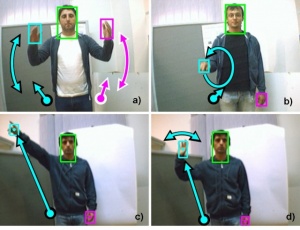Behavior recognition from visual data
From AIRWiki
| Title: | Behavior recognition from visual data |
Image:gesturelib.jpg |
| Description: | In the literature several approaches have been used to model observed behaviors and these date back to early approaches in animal behavior analysis (Baum and Eagon, 1967)(Colgan, 1978). Nowadays several techniques are used and they can be roughly classified as: State space models, Automata (e.g., Finite State Machines, Agents, etc.), Grammars (e.g., strings, T-Patterns, etc.), Bayeasian models (e.g., Hidden Markov Models), and Dynamic State Variables. The work will leverage on a huge corpus of techniques to devise the most suitable for behavior recognition from visual data. We exclude from the very beginning any deterministic approach being the phenomenon under observation complex and affected by noisy observations. The focus will be mainly of the use of dynamic graphical models (Ghahramani, 1998) and the application of bottom up learning techniques (Stolcke and Omohundro, 1993)(Stolcke and Omohundro, 1994) for model induction.
Material:
Expected outcome:
Required skills or skills to be acquired:
| |
| Tutor: | MatteoMatteucci (matteo.matteucci@polimi.it), AndreaBonarini (andrea.bonarini@polimi.it) | |
| Start: | 2012/04/01 | |
| Students: | 1 - 2 | |
| CFU: | 20 - 20 | |
| Research Area: | Machine Learning | |
| Research Topic: | none | |
| Level: | Ms | |
| Type: | Thesis | |
| Status: | Closed |
